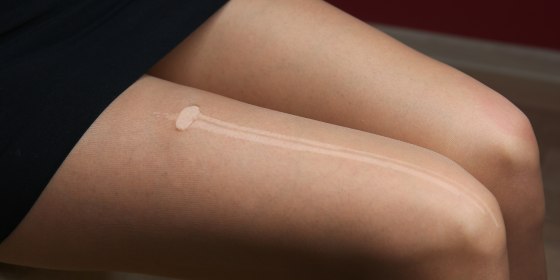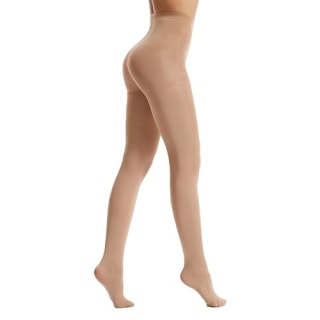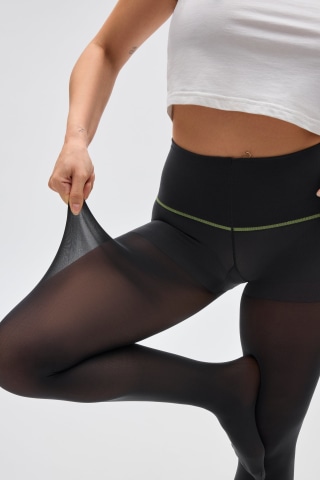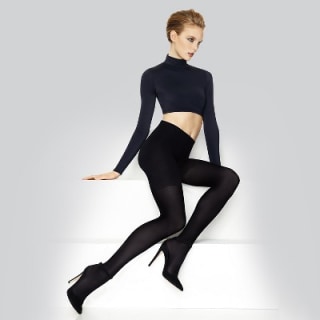We don’t always have the answers, but we have some people on speed dial who do — which is why we present to you our series FYI where we have experts explain if lip balm is actually bad, how often you should wash your hair and more.
There are lots of pros when it comes to wearing tights — they keep your legs warm, look sleek and can streamline your figure under a dress or skirt. One of the only cons? They tend to rip easily. “Tights are made from highly elastic materials like nylon and polyester blends to ensure flexibility and a snug fit and these materials are delicate by nature,” says Simon Elliott, the founder and operations director of the clothing brand Clifton. “Even minor snags or overstretching can compromise their structural integrity, leading to rips.” Because of this, it’s important to take care when you wash, wear and store your tights.
To help you prevent snags, we spoke to clothing and textile experts. Below, they share their top tips on how to keep your tights free of rips, plus share advice on what to do if you notice a small snag and how to shop for tights that are durable and less likely to tear.
SKIP AHEAD 6 tips that can help you prevent rips in tights | What to do if you notice a small rip in your tights | Tights that are less prone to ripping
6 tips to prevent rips in tights
The same way that keeping leather in good shape requires certain practices, as does learning how to wash sweaters to prevent damage, how you care for your tights will be a huge factor that impacts their longevity. With hosiery, the key is to avoid ripping them — which can be a challenge because of how delicate they are. According to experts we spoke with, the following tips can help prevent rips in your tights.
Stick them in the freezer
Yes, you read that right. Sticking your tights in the freezer after you buy them may help prevent future tears and snags. “Freezing tights can strengthen the fibers temporarily by tightening their bonds,” says Elliott. “This process helps reinforce the fibers, reducing the risk of runs.”
So, how do you do it? Elliott says to rinse tights with water and gently squeeze out excess water. Then, place them in a plastic bag, and freeze them overnight. From there, you’ll want to pull them out at least a few hours before wearing them so they can thaw and come to room temperature, says Grace Thompson, a product manager at the bridal fashion retailer ChicSew.
Moisturize your skin
Think about it: Dragging tights over sandpaper would surely cause them to snag, right? While your legs may not be as rough as sandpaper, dry skin can easily snag delicate tights, says Elliott. “Because of this, it’s important to make sure your legs are moisturized and free of rough patches before slipping on tights.” To make sure your skin is hydrated and soft all through the winter, apply body lotion in the morning before getting dressed. The same goes for your feet and heels, which can have jagged calluses that will tear your tights. The general rule: Make sure anywhere your tights will touch is smooth and hydrated.
Be gentle putting them on
If you’re in a rush, an outfit that requires tights may not be the best option. Go too fast and you’ll risk ripping your tights instantly. Here’s the ideal way to put them on if you want to mitigate the risk of rips: Roll the tights down to the toes and gradually roll them up your legs, says Thompson. “Going slowly and not yanking them reduces the stress put on the fabric, making it less likely that they’ll snag.” Even if they don’t rip in the moment, yanking will weaken fabric over time so that they’ll be more prone to damage, adds Elliott.
Think about what else you’re wearing
Accessories can make your outfit — but they can also rip your tights. “Jewelry with sharp edges or prongs can easily catch on the fine knit of your tights and cause tears,” says Elliott, who suggests either avoiding wearing it all together or at least putting it on after you have put on tights. On that note, your undies could also cause a problem. “Opt for seamless or smooth-edged underwear when wearing tights to minimize friction that can cause snags,” says Thompson.
Go gentle when washing
Another prime place tights get ruined? In the washing machine. If you toss them in with your regular laundry, there is a good chance they’ll get caught on zippers, buttons or other rough fabrics they’re mingling with as they go through the spin cycle. If you do need to wash them with other items, place them in a mesh laundry bag to keep them contained and protected, says Elliott.
Even more preferable would be to wash them with other delicates on the gentle cycle or via hand washing. “High intensity spin cycles can stretch fabric excessively, which will weaken it,” says Elliott.
Store them smartly
Just like you want to be careful with your tights mixing with other items while washing them, you should also think about what items you intend to store them with. Many people toss tights in a lingerie drawer. The only problem with this is bras often have hooks that can get caught on tights. Ideally, you’d store them on their own to prevent them from getting snagged, says Thompson. If you don’t have the room for this, consider placing them in their own bag (even a gallon sized plastic kitchen bag will work) so that they’re protected. “And definitely avoid hanging them, which can stretch the fibers too much,” says Thompson.
What to do if you notice a small rip in your tights
Even if you abide by all the tips above, things happen and you may find yourself dealing with a snag or tear. This can especially be a bummer if you’re mid-way through the day and don’t have the option of changing. Thankfully, there is something you can do to avoid a small rip from getting bigger. “If you see a run, apply clear nail polish around the edges of that run to stop it from spreading,” says Elliott. “This works by sealing the fibers and preventing further fraying.”
Don’t have any clear nail polish on you? “A small piece of clear tape can be a great alternative,” says Thompson. “It helps to keep the fabric together and prevents stretching, which can expand the run.”
Highly rated tights that are less prone to ripping
The type of tights you buy can also go a long way toward avoiding rips. “Thicker materials are generally more resistant to runs,” says Elliott. “Look for a high denier count — ideally something between 60 and 100 denier.” Not familiar with a denier count? It’s a unit of measurement that indicates the thickness of a material. “Tights made with higher percentages of spandex tend to be more durable and retain their elasticity better,” says Elliott. Below, I rounded up a few highly rated options with a high denier count or a high percentage of spandex in them.
Frola Women’s 80 Denier Soft Semi Opaque Tights
These tights have a denier count of 80, meaning they’re on the thicker side and less likely to snag, according to our experts. They are made from a nylon and spandex blend, come in sizes small through XXL and are available in 33 colors — including black, coffee and navy blue. They also have a 4.5-star average rating from over 7,800 reviews on Amazon. One thing to note: These tights aren’t machine-washable.
Sheertex Stubbornly Strong Sheer Rip-Resist Tights
I bought these tights after seeing them all over social media — where people were raving that they never ripped. They’re made with patent-pending technology that uses strong polymers to create resilient fibers that allow them to be sheer but sturdy, according to the brand. I have actually fallen on rough concrete in these tights and they haven’t ripped. I also appreciate that they have a wide waistband that doesn’t roll down and go all the way up to a size 3XL.
Spanx Tight-End Tights
These tights, which have a 4.3-star average rating from over 1,220 reviews on Amazon, have extra compression in the stomach, thighs and butt to provide a streamlined silhouette. The tights are thick and opaque and come in black or charcoal. You can wear them with or without underwear to avoid visible panty lines, too, according to the brand.
Hanes Premium Women’s Perfect Blackout Tights Black
These tights have a 100 denier count, making them one of the thicker options on our list. They only come in black, however, and are available in sizes small through extra large. These tights have a flexible waistband and a built-in smoothing panty so you don’t need to wear underwear with them, according to Hanes.
CozyWow Semi Opaque Footed Tights
If you like bright tights, these are for you. They come in 27 colors — including fuschia, dark green and red — and in sizes extra small through 3XL. They have a denier count of 80, making them thick and semi opaque. These tights also have a thick waistband to prevent it from rolling and a reinforced toe to prevent tears in that area, according to the brand.
Meet our experts
At NBC Select, we work with experts with specialized knowledge and authority based on relevant training and experience. We also ensure all expert advice and recommendations are made independently and without undisclosed financial conflicts of interest.
- Simon Elliott is the founder and operations director of Clifton, a custom clothing brand.
- Grace Thompson is a product manager at the bridal retailer ChicSew.
Why trust NBC Select?
Bethany Heitman is a contributor at NBC Select and a journalist who regularly covers beauty, home and lifestyle. For this story, she interviewed textile and clothing experts on how to prevent rips in your tights and researched highly rated options with high denier counts.
Catch up on NBC Select’s in-depth coverage of personal finance, tech and tools, wellness and more, and follow us on Facebook, Instagram, Twitter and TikTok to stay up to date.








